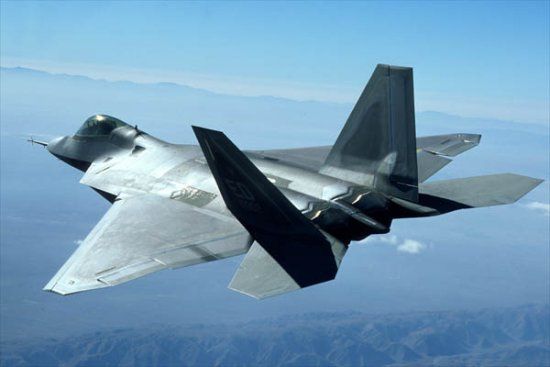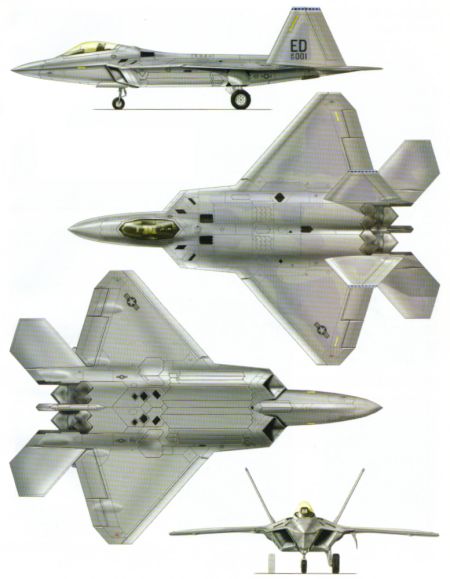|
||||||||||
|
|
||||||||||
|
||||||||||
|
|
||||||||||
 - -
|
|

|
Lockheed Martin F-22 Raptor Air Superiority Fighter |
|
DESCRIPTION:
The F-22 won the Air Force's Advanced Tactical Fighter contest over the Northrop YF-23 in April 1991. While the aircraft's primary mission remains air superiority, for which it can carry up to 8 air-to-air missiles internally, a secondary ground-attack role has also been developed. This capability was highlighted when the Raptor was briefly renamed the F/A-22 in late 2002, though it has again been designated as the F-22 since December 2005. The F-22 was designed primarily to supplement and replace the F-15 by incorporating new stealth features and propulsion technology. These advances include its angular design, use of radar-absorbant composite materials, and the ability to "supercruise" at supersonic speeds without using an afterburner. The F-22 also emphasizes agility through the use of thrust vectoring nozzles and a sophisticated fly-by-wire control system. Other advanced systems aboard the Raptor include an integrated avionics suite built around a powerful flight computer with three times the memory and 16 times the speed of that used on the F-15. The F-22 also uses a nav/attack system that incorporates artificial intelligence to filter information to the pilot reducing his workload as well as improving his situational awareness. Two prototypes of both the YF-22 and YF-23 were constructed. One example of each aircraft was powered by Pratt & Whitney F119 turbofans and the other by the General Electric F120 turbofans. These various combinations allowed the Air Force to select the best airframe/propulsion match. The second YF-22 prototype, fitted with Pratt & Whitney engines, soon demonstrated the ability to cruise at Mach 1.58 without afterburner and Mach 1.7 with afterburner. This combination was deemed the most desirable, and both Lockheed and Pratt & Whitney were issued contracts to proceed with production. The production F-22 Raptor includes a number of modifications when compared to the YF-22 prototype, including greater wingspan, reduced wing sweep, a shortened fuselage, and a relocated cockpit to improve visibility. Despite its advanced systems and exceptional performance, F-22 production has been limited due to the aircraft's high pricetag that has been estimated as high as $250 million apiece. Costs decreased as F-22 production methods improved, however, and the flyaway cost was estimated at $133 million in 2005. Lockheed Martin has also indicated that F-22 unit cost may drop below $100 million in future production lots. Regardless, even these cost reductions have proven insufficient as the Obama administration convinced Congress to cancel further funding for the Raptor program. The Air Force had originally hoped to purchase 750 examples of the F-22 and still states a requirement for at least 380 planes. Nevertheless, budget plans have slashed the anticipated F-22 fleet to 187 aircraft with production scheduled to end in 2011. By late 2008, some 130 F-22 Raptors had been delivered to the Air Force. The Raptor program was set back by numerous delays in manufacturing, software development, and flight testing that pushed service entry back by several years. Operational Testing finally commenced at Nellis and Edwards AFB in October 2003, and a pilot training squadron was established at Tyndall AFB. The first operational squadron was the 27th Fighter Squadron at Langley AFB that reached initial operational capability in December 2005. Upon entering service, the Raptor has been cleared to carry the AIM-120 AMRAAM medium-range air-to-air missile, the AIM-9M Sidewinder short-range air-to-air missile, and the GBU-32 JDAM 1,000-lb GPS-guided bomb. Other weapons being integrated aboard the F-22 include the GBU-39 SDB GPS-guided bomb and the latest AIM-9X variant of Sidewinder. The US Congress has so far voted to deny export of the F-22 to foreign countries, but Japan and Israel have expressed strong interest in purchasing the plane. Australia also made a bid but has instead chosen to buy the F-35.
Last modified 25 April 2011
|
|
| HISTORY: | |
| First Flight |
(YF-22) 29 September 1990 (F-22A) 7 September 1997 |
|
Service Entry
|
15 December 2005
|
| CREW: |
one: pilot
|
|
ESTIMATED COST:
|
$142 million [2008$]
|
| AIRFOIL SECTIONS: | |
| Wing Root | NACA 64A?05.92 |
|
Wing Tip
|
NACA 64A?04.29
|
| DIMENSIONS: | |
| Length | 62.08 ft (18.92 m) |
| Wingspan | 44.50 ft (13.56 m) |
| Height | 16.42 ft (5.00 m) |
| Wing Area | 838 ft² (78.0 m²) |
|
Canard Area
|
not applicable
|
| WEIGHTS: | |
| Empty | 43,340 lb (19,660 kg) |
| Normal Takeoff | 60,000 lb (27,215 kg) |
| Max Takeoff | 83,500 lb (37,875 kg) |
| Fuel Capacity |
internal: 20,650 lb (9,365 kg) external: 15,865 lb (7,195 kg) in four 600 gal (2,270 L) tanks |
|
Max Payload
|
3,915 lb (1,775 kg) [internal] approximately 19,000 lb (8,620 kg) [external] |
| PROPULSION: | |
| Powerplant | two Pratt & Whitney F119-100 afterburning turbofans |
| Thrust |
70,000 lb (310 kN)
|
| PERFORMANCE: | |
| Max Level Speed |
at altitude: 1,355 mph (2,180 km/h) at 30,000 ft (9,150 m), Mach 2 [afterburner] 1,070 mph (1,725 km/h) at 30,000 ft (9,150 m), Mach 1.6 [supercruise] at sea level: 920 mph (1,480 km/h), Mach 1.2 |
| Initial Climb Rate | unknown |
| Service Ceiling | 50,000 ft (15,240 m) |
| Range |
typical: 2,000 nm (3,700 km) ferry: unknown |
| Endurance | unknown |
| g-Limits |
+9.0 / -3.0
|
| ARMAMENT: | |
| Gun | one 20-mm M61A2 Vulcan cannon (480 rds) |
| Stations | four internal weapons bays and four external hardpoints |
| Air-to-Air Missile |
AIM-9M Sidewinder, AIM-120A/C AMRAAM AIM-9X Sidewinder planned |
| Air-to-Surface Missile | none |
| Bomb |
GBU-32 JDAM GBU-39 Small Diameter Bomb planned |
| Other |
unknown
|
| KNOWN VARIANTS: | |
| YF-22 | Prototype evaluated under the Advanced Tactical Fighter competition; 2 built |
| F-22A | Production model with a slightly shorter fuselage, reduced wing sweep, and the cockpit shifted forward to improve visibilty; 187 to be built |
| F/A-22A | Designation given to the F-22A in 2002 to highlight the plane's air-to-ground combat capabilities, but dropped upon service entry in 2005 when the model was again called the F-22A |
| F-22B | Proposed two-seat combat-capable trainer; cancelled |
| F/A-22X or F-22X | Proposed advanced variant that would add a synthetic aperture radar (SAR), moving target indicator (MTI), and additional ground attack capability within the same sized bay as the F-22A but modified to carry up to two Wind Corrected Munitions Dispensers (WCMD) or two 1,000-lb JDAMs or eight SDBs |
| F-22E | Lockheed proposal for an upgraded version based on the F-22A with improved ground attack capability by adding a 40-inch insert so internal weapons carriage could be increased to four 2,000-lb JDAMs, 16 SDBs, or four WCMDs and incorporating an internal Forward Looking Infrared (FLIR) and targeting system as well as SAR and MTI modes to the radar, the changes would increasing empty weight by 4,000 to 8,000 lb and increase range by adding fuel capacity |
| F-22N | Proposed navalized variant with variable-sweep wings for operation from US Navy aircraft carriers; not developed |
| FB-22 |
Lockheed concept for a long-range high-altitude bomber based on the F-22; design would eliminate all tail
surfaces, incorporate a new delta wing with increased fuel capacity, and employ a longer fuselage with
room for stretched weapons bays carrying two AIM-120 missiles and up to 24 small diameter bombs; the Air
Force has indicated that it will not order the design
|
|
KNOWN COMBAT RECORD:
|
US Homeland Security - Operation Noble Eagle (USAF, 2006-present)
|
|
KNOWN OPERATORS:
|
United States (US Air Force)
|
|
3-VIEW SCHEMATIC:

|
|
SOURCES:
|
|


|
Aircraft | Design | Ask Us | Shop | Search |

|
|
| About Us | Contact Us | Copyright © 1997-2023 | |||
|
|
|||